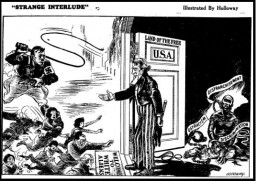<< Previous | Displaying results 6501-6525 of 6707 for "" | Next >>
-
Soldiers of the Armia Krajowa
PhotoSoldiers of the Polish Home Army (Armia Krajowa) take cover behind a barricade during the Warsaw Polish uprising. During the uprising, the Home Army was supported by 2,500 soldiers from other resistance movements, such as the National Armed Forces (Narodowe Siły Zbrojne, NSZ) and the communist People's Army (Armia Ludowa, AL). Only a quarter of the partisans had access to weapons, fighting against 25,000 German soldiers equipped with artillery, tanks, and air forces. Two of the three soldiers shown here…

-
Female Soldiers of the Polish Home Army
PhotoSoldiers of the Polish Home Army Women's Auxiliary Services, taken captive by the Germans in October 1944 as a result of the Warsaw Polish uprising. After the uprising ended on October 2, the Germans took as prisoners of war more than 11,000 soldiers of the Polish Home Army.

-
Buildings destroyed during the Warsaw Polish uprising
PhotoPlanned as a short military revolt, the Warsaw Polish uprising lasted 63 days, from August to October 1944. In the end, German troops destroyed the majority of Warsaw during and immediately after the uprising. Photo dated January 17, 1945.
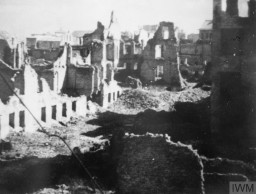
-
Warsaw Polish uprising
PhotoSoldiers from the Kiliński Battalion of the Polish Home Army take a German prisoner during the Warsaw Polish uprising. August 20, 1944.
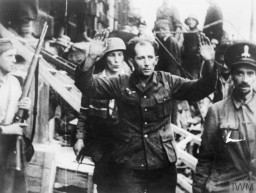
-
Destruction in Warsaw
PhotoFollowing the German invasion of Poland on September 1, 1939, Warsaw suffered heavy air attacks and artillery bombardment. German troops entered the city on September 29, shortly after its surrender. This photograph was taken by Julien Bryan, an American documentary filmmaker who captured the German bombardment and its impact on the Polish citizenry. Warsaw, Poland, ca. 1939.
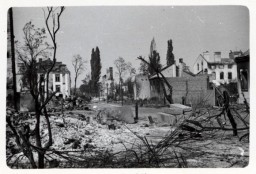
-
Home destroyed during Warsaw bombing
PhotoMembers of a Polish family perform daily chores amidst the amidst the charred ruins of their home, destroyed during the German bombing of Warsaw. They have reassembled the remnants of their household furnishings outside. Photographed by Julien Bryan, circa 1939.

-
Polish children wander through the ruins of Warsaw
PhotoPolish children wander through the ruins of Warsaw after a German bombing. Photographed by Julien Bryan in Warsaw, Poland, ca. 1939.
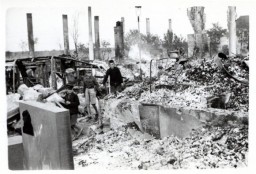
-
Victim of a German air raid
PhotoA ten-year-old Polish girl, Kazimiera Mika, mourns the death of her older sister, who was killed in a field in Warsaw, Poland, during a German air raid. Photographed by US documentary filmmaker, Julien Bryan, on September 13, 1939.
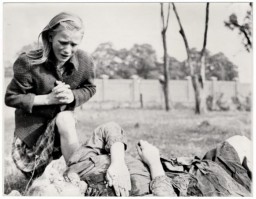
-
Father Wlodarczyk tries to clean a bombed-out church
PhotoFather Wlodarczyk attempts to clean and repair a bombed-out church in the besieged city of Warsaw. Photographed by Julien Bryan, Warsaw, Poland, ca. 1939.
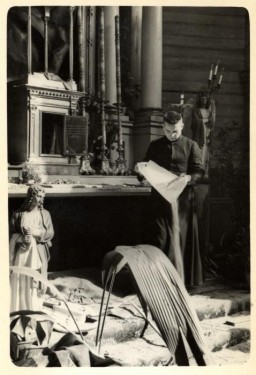
-
Judge Benjamin Barr Lindsey
PhotoAmerican judge Benjamin Barr Lindsey and his wife on a ship. Judge Lindsey's writings were among the texts the Nazis singled out during the 1933 public burnings of books. Photo dated December 4, 1915.

-
John Reed
PhotoPortrait of American journalist John Reed, circa 1914. Reed's book Ten Days that Shook the World was among the texts Nazi students burned in 1933.
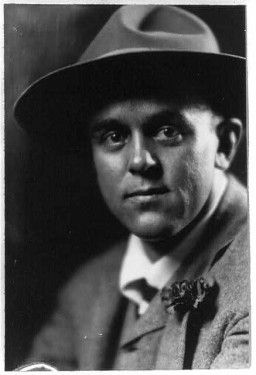
-
Morris Hillquit
PhotoBorn in Riga, Morris Hillquit became a prominent theoretician of the socialist movement after immigrating to the United States. The German translation of his work Socialism in Theory and Practice was burned in Nazi Germany in 1933. Photo taken circa 1910–1915.
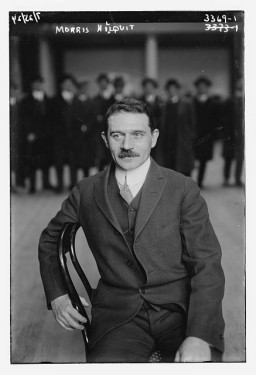
-
Nazi propaganda depicting prominent Jewish figures
PhotoNazi-produced propaganda slide entitled "Leading Figures of the System." The image was presented during a lecture called "Jewry, Its Blood-based Essence in Past and Future," Part I in a series on Jewry, Freemasonry, and Bolshevism. Germany, circa 1936. The slide features the portraits of six prominent Jewish political and cultural figures in Weimar Germany. Georg Bernhard, Rudolf Hilferding, and Walther Rathenau were among the authors whose works were targeted during the 1933 Nazi book burnings.
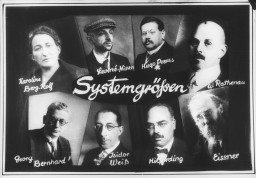
-
Portrait of writer Sigrid Undset
PhotoPortrait of writer Sigrid Undset, who won the Nobel Prize for Literature in 1928. Often with feminist themes, her novels were banned and burned in part because of her public criticism of the Nazi regime. Photo taken by Anders Beer Wilse on July 1, 1923.
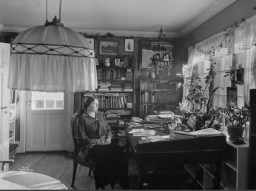
-
Sigrid Undset
PhotoSigrid Undset's novels were among the texts the Nazis banned and burned. Undset had previously won the Nobel Prize for Literature in 1928.
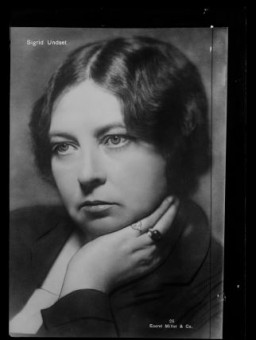
-
Vladimir Lenin
PhotoVladimir Lenin was the leader of a faction of Russian communists known as the Bolsheviks. After the Russian Revolution broke out in 1917, Lenin seized control and established the Soviet Union. Photographed circa 1920. The Nazis had declared themselves the sworn enemies of Bolshevik Russia, its architect and dictator Vladimir Lenin, and his successor Josef Stalin.
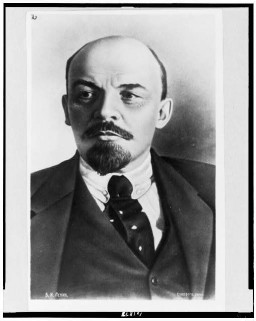
-
Joachim von Ribbentrop
PhotoForeign Minister of Germany from 1938 to 1945, Joachim von Ribbentrop sits in his cell during the Nuremberg trials. Photographed circa November 20, 1945 – October 01, 1946.

-
Propaganda slide for Hitler Youth
PhotoPropaganda slide for a Hitler Youth educational presentation entitled "German Achievements in the East." Circa 1934–1937.
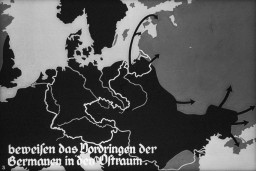
-
Prisoners in the roll call area at Melk
PhotoNewly arrived prisoners are assembled in the Appellplatz (roll call area) at the Melk camp, a subcamp of Mauthausen in Austria. 1944–45.

-

-
Nazi "Euthanasia" Program
PhotoPsychiatric patients are evacuated to clinics where they will be murdered as part of the Nazi Euthanasia Program. Photo taken in Germany and dated circa 1942–1944. The term "euthanasia" usually refers to causing a painless death for a chronically or terminally ill individual who would otherwise suffer. In the Nazi context, however, "euthanasia" was a euphemistic or indirect term for a clandestine murder program that targeted individuals with physical and mental disabilities.

-
Nazi Racial Propaganda
PhotoNazi propaganda depicting two racial portraits of individuals considered non-Aryan. The original caption reads: "Then these are barely recognizable as human beings." Circa 1933–1943.

-
Segregation in the United States
PhotoA segregated drinking fountain on the county courthouse lawn in Halifax, North Carolina. Photographed by John Vachon in April 1938.
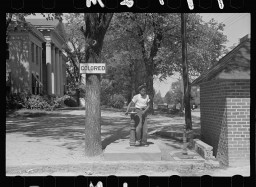
-
The Ku Klux Klan
PhotoThe Ku Klux Klan marches down Pennsylvania Ave in Washington, DC. Photograph by Harris & Ewing, 1926.
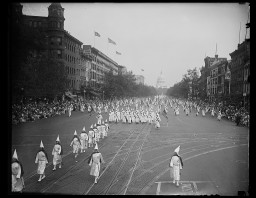
-
American cartoon responding to racism and the refugee crisis
PhotoCartoon depicting the United States' response to the refugee crisis in Europe, as well as the racism and discrimination African Americans faced at home. The Pittsburgh Courier, April 16, 1938. Page 10. Domestic concerns in the United States, including unemployment and national security, combined with prevalent antisemitism and racism, shaped America's immigration policies, responses to Nazism, and willingness to aid European Jews.
